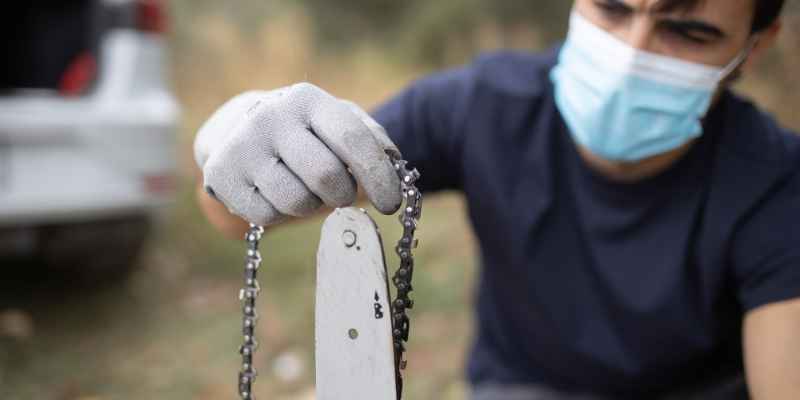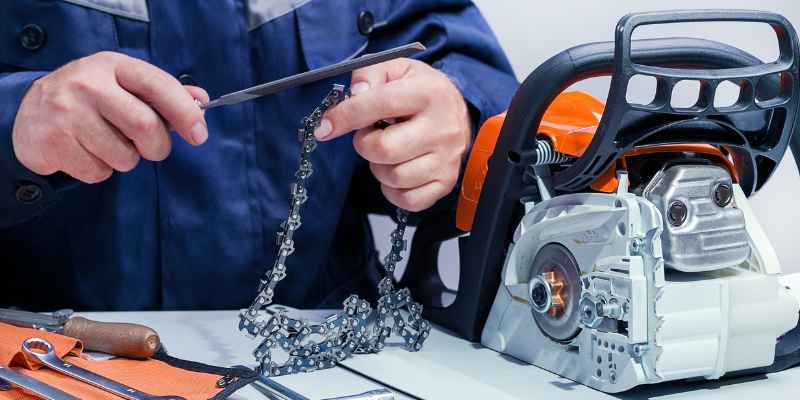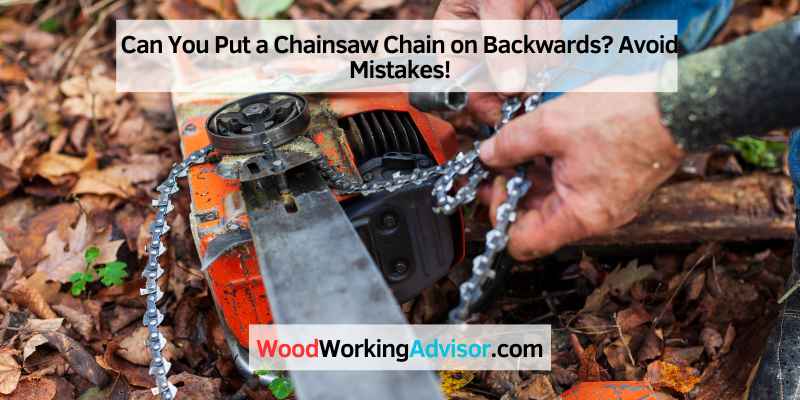Yes, you can put a chainsaw chain on backwards. However, doing so will result in a dangerous situation and damage to the chainsaw.
Putting a chainsaw chain on backwards may seem like an easy mistake to make, but it can have serious consequences. The teeth on a chainsaw chain are designed to cut in one direction only, and if the chain is installed backwards, it will not cut properly.
This can cause the chainsaw to kick back, which is a dangerous situation that can result in serious injury or even death. Additionally, running the chainsaw with the chain installed backwards can cause damage to the chainsaw itself. It is important to always double-check the installation of the chainsaw chain before using the tool to ensure safety and proper function.
The Direction Dilemma: Chainsaw Chain Orientation
Putting a chainsaw chain on backwards can lead to safety hazards and poor cutting performance. Make sure to install the chain with the cutting teeth facing the right direction for optimal operation. Avoid any potential risks by following the correct chain orientation guidelines.
Signs Of A Backward Chain
Putting a chainsaw chain on backward is not only possible, but it’s also a common mistake made by many inexperienced chainsaw users. The most obvious sign of a backward chain is that it won’t cut properly, and the chainsaw will produce sawdust instead of wood chips. Moreover, the chain will appear loose, and the teeth will face the wrong direction. If you notice any of these signs, it’s best to stop using the chainsaw immediately and check the chain orientation.
Consequences Of Incorrect Installation
Installing a chainsaw chain backward can have severe consequences for both the user and the equipment. Using a backward chain can cause the chainsaw to overheat, leading to damage to the engine and other parts. Additionally, the backward chain can cause kickbacks, which can be dangerous for the user and those around them. Kickbacks occur when the chain is thrown back towards the user, causing severe injuries or even death. Therefore, it’s crucial to ensure that the chainsaw chain is installed correctly to avoid any potential risks.
In conclusion, installing a chainsaw chain backward is a simple mistake that can have severe consequences. It’s important to check the chain orientation before using the chainsaw to prevent any damage to the machine and ensure the safety of the user. Keep these tips in mind, and you’ll be able to use your chainsaw safely and effectively.
Anatomy Of A Chainsaw Chain
Understanding the components of a chainsaw chain is crucial for maintaining its proper functioning and ensuring your safety while operating the chainsaw. Each part of the chain plays a significant role in the cutting process, and it’s essential to familiarize yourself with its anatomy. In this section, we will explore the various components that make up a chainsaw chain.
Understanding Chain Components
The chainsaw chain consists of several key components that work together to deliver optimal cutting performance. Let’s take a closer look at each of these components:
- Drive Links: The drive links are the teeth-like protrusions on the underside of the chain that fit into the guide bar’s groove. These links engage with the sprocket, allowing the chain to rotate.
- Cutting Teeth: The cutting teeth are the sharp, curved blades that do the actual cutting. They are positioned along the top side of the chain, and their design may vary depending on the type of cutting task.
- Rakers: Also known as depth gauges, the rakers are the small metal projections located between the cutting teeth. They determine how deep the cutting teeth penetrate into the wood during each pass.
- Drive Links: The drive links are the metal links that connect the cutting teeth to the drive links. They transfer power from the engine to the cutting teeth, enabling them to perform their cutting action.
Identifying The Cutting Edge
The cutting edge of a chainsaw chain refers to the part of the chain responsible for slicing through wood. Proper identification of the cutting edge is crucial for installing the chain correctly and ensuring optimal cutting performance. The cutting edge can be identified by examining the shape and orientation of the cutting teeth.
When looking at the chain, you will notice that the cutting teeth have a curved shape. The inside of the curve is the cutting edge, while the outside is the non-cutting edge. It’s important to ensure that the cutting edge is facing towards the front of the chainsaw when installing the chain. Placing the chain backward can lead to inefficiency and potential safety hazards.
Now that we have explored the anatomy of a chainsaw chain, you have a better understanding of its components and how they contribute to the cutting process. By familiarizing yourself with these components and correctly identifying the cutting edge, you can ensure that your chainsaw operates smoothly and efficiently, allowing you to tackle your cutting tasks with confidence.

Common Mistakes When Mounting A Chainsaw Chain
Mounting a chainsaw chain backward is a common mistake that can lead to safety hazards and poor cutting performance. Ensure proper orientation to prevent damage to the chainsaw and potential accidents during operation. Always follow manufacturer guidelines for correct installation to maintain chainsaw efficiency.
Mix-ups During Chain Replacement
One of the most common mistakes when mounting a chainsaw chain is mixing up the direction in which it should be installed. It may seem simple, but putting a chainsaw chain on backwards can have serious consequences. This mix-up can affect the performance, safety, and durability of your chainsaw. To avoid this error, it’s crucial to pay attention to the correct orientation of the chain during replacement.
When installing a chainsaw chain, it’s important to note that the cutting teeth should be facing forward and positioned in the correct direction. The cutting teeth are designed to cut through wood efficiently when they rotate in the proper direction. If the chain is installed backwards, the cutting teeth will be moving in the wrong direction, leading to ineffective cutting and potentially dangerous situations.
Misreading The Manufacturer’s Guide
Another common mistake when mounting a chainsaw chain is misreading or disregarding the manufacturer’s guide. Each chainsaw model may have specific instructions on how to properly install the chain. Ignoring these guidelines can lead to improper tensioning, alignment issues, and decreased performance.
To avoid this mistake, it’s essential to carefully read the manufacturer’s guide before attempting to replace the chainsaw chain. The guide will provide step-by-step instructions, including the correct tensioning method, chain orientation, and any additional precautions specific to your chainsaw model. By following the manufacturer’s recommendations, you can ensure the chain is mounted correctly and optimize the performance and longevity of your chainsaw.
In conclusion, when it comes to mounting a chainsaw chain, it’s crucial to avoid common mistakes that can compromise the effectiveness and safety of your chainsaw. Mixing up the chain’s direction and misreading the manufacturer’s guide are two errors that can easily be avoided by paying attention to the correct orientation and following the provided instructions. By properly mounting the chainsaw chain, you can enhance the cutting efficiency, protect yourself from potential accidents, and prolong the lifespan of your chainsaw.
Step-by-step: Correctly Installing Your Chainsaw Chain
Installing your chainsaw chain correctly is crucial to ensure safe and efficient operation. Putting a chainsaw chain on backwards can lead to kickback, poor cutting performance, and potential damage to the saw. Follow the manufacturer’s guidelines, pay attention to the chain’s cutting direction, and double-check the installation to avoid putting the chainsaw chain on backwards.
Preparation And Safety Measures
Before installing your chainsaw chain, ensure that the chainsaw is turned off and the spark plug is disconnected to prevent accidental starts. Wear protective gloves and goggles to shield yourself from potential injury.
Securing The Chain In The Right Direction
Place the chainsaw on a flat, stable surface. Loosen the chain tensioning screw and remove the side cover, ensuring the chain brake is engaged. Align the chain in the proper cutting direction, making sure the teeth point towards the chainsaw’s front.
Troubleshooting: When Something Doesn’t Feel Right
If your chainsaw chain doesn’t feel right, it’s possible that you’ve put it on backwards. To troubleshoot this issue, carefully inspect the direction of the teeth on the chain. Reversing the chain could lead to poor performance and potential safety hazards, so it’s crucial to ensure proper installation.
Diagnosing Cutting Issues
When it comes to using a chainsaw, it’s important to ensure that everything is in proper working order. One common issue that can affect the performance of your chainsaw is putting the chainsaw chain on backwards. This can lead to cutting issues and make the chainsaw difficult to use effectively. In this section, we will discuss troubleshooting techniques to identify and resolve cutting issues when the chainsaw chain is put on backwards.
Adjusting A Misaligned Chain
If you suspect that your chainsaw chain is on backwards, the first step is to diagnose the problem. Start by checking the direction of the cutting teeth on the chain. The cutting teeth should face forward, with the sharp edge of the tooth pointing towards the front of the chainsaw. If the teeth are facing the wrong direction, you will need to adjust the chain to ensure it is aligned correctly.
To adjust a misaligned chain, follow these steps:
- Start by turning off the chainsaw and ensuring that it is completely powered down.
- Locate the chain tensioning mechanism, which is typically a screw or knob on the side of the chainsaw.
- Loosen the chain tension by turning the tensioning screw counterclockwise. This will allow you to adjust the position of the chain.
- Carefully remove the chain from the guide bar, making sure to keep track of the correct orientation.
- Inspect the chain for any damage or wear. If necessary, replace the chain with a new one.
- Reinstall the chain onto the guide bar, ensuring that the cutting teeth are facing the correct direction.
- Tighten the chain tension by turning the tensioning screw clockwise until the chain is snug against the guide bar.
- Double-check the alignment of the chain to ensure that it is properly positioned.
- Finally, test the chainsaw by making a few cuts to see if the cutting performance has improved.
By following these steps, you can easily adjust a misaligned chain and resolve cutting issues caused by putting the chainsaw chain on backwards. Remember to always prioritize safety and consult the manufacturer’s manual for specific instructions on adjusting the chain tension for your particular chainsaw model.
Maintenance Tips To Keep Your Chainsaw In Top Shape
Maintenance is crucial to keep your chainsaw in top shape and ensure it operates safely and efficiently. By following some simple maintenance tips, you can prolong the life of your chainsaw and prevent costly repairs. In this article, we will discuss some essential maintenance practices to keep your chainsaw in optimal condition.
Regular Cleaning And Lubrication
Regular cleaning and lubrication are essential for the proper functioning of your chainsaw. After each use, make sure to clean the chainsaw thoroughly to remove any debris, sawdust, or oil buildup. Use a brush or compressed air to clean the chain, guide bar, and sprocket area. Additionally, applying lubricant to the chain and guide bar will prevent premature wear and ensure smooth operation. Regular cleaning and lubrication will extend the life of your chainsaw and maintain its cutting performance.
Inspecting Chain Tension And Wear
Inspecting chain tension and wear is vital to prevent accidents and ensure efficient cutting. Check the chain tension regularly and adjust it as needed to prevent it from slipping off the guide bar. Examine the chain for signs of wear, such as dull or damaged cutting teeth. Replace the chain if it is worn out to maintain optimal cutting performance and prevent kickback. Additionally, ensure that the drive links fit snugly into the guide bar groove to maintain proper tension and prevent accidents.
Expert Advice: What Professionals Say
Insights From Experienced Lumberjacks
Seasoned lumberjacks emphasize the importance of proper chain installation.
Installing a chainsaw chain backward can lead to safety hazards.
Workshops And Training Resources
Lumberjacks recommend attending workshops for hands-on guidance.
Training resources offer step-by-step instructions for chain placement.
Avoiding Future Mistakes: Best Practices
When it comes to installing a chainsaw chain, avoiding mistakes is crucial. Let’s explore the best practices to prevent errors in chain installation.
Creating A Checklist For Chain Installation
- Check chain direction before installing.
- Ensure proper tension for smooth operation.
- Inspect for any damage or wear on the chain.
Investing In Quality Chains And Tools
Quality chains and tools are essential for efficient chainsaw operation. Investing in durable chains and tools ensures longevity and optimal performance.

Frequently Asked Questions
Can A Chainsaw Chain Be Put On Backwards?
Yes, a chainsaw chain can be put on backwards, but it will not cut efficiently and can be dangerous. The cutting teeth should always face forward to ensure proper cutting performance and safety.
What Happens If You Install A Chainsaw Chain Backward?
Installing a chainsaw chain backward will result in inefficient cutting, kickbacks, and potential accidents. The chain won’t cut smoothly, and the chainsaw may become difficult to control. Always ensure the cutting teeth are facing the correct direction.
How To Know If A Chainsaw Chain Is Installed Correctly?
To ensure a chainsaw chain is installed correctly, check that the cutting teeth are facing forward and the drive links engage with the bar. Test the chain by running it at a low speed to see if it cuts smoothly without resistance.
Why Is It Important To Install A Chainsaw Chain Properly?
Installing a chainsaw chain properly is crucial for efficient cutting performance and safety. A correctly installed chain ensures smooth cutting action, reduces the risk of kickbacks, and maintains the overall functionality and longevity of the chainsaw.
Conclusion
Putting a chainsaw chain on backwards can cause serious safety and performance issues. It’s crucial to carefully follow the manufacturer’s instructions when installing a chainsaw chain to avoid potential damage and accidents. By understanding the correct orientation, you can ensure the safe and efficient operation of your chainsaw.

